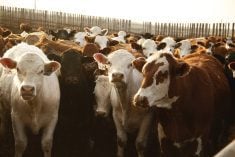The Canadian consumer’s support for the beef industry has resulted in increased consumption for 2003.
“We were the first country to have an increase after an incident of BSE,” said Glenn Brand, merchandising manager for the Beef Information Centre.
Last year was the first time Canada broke the one million tonne mark in total beef consumption.
Statistics Canada figures released May 26 showing beef consumption rose five percent, but at the expense of pork, which fell by almost 10 percent in the early months of the BSE announcement.
Read Also

Growth plates are instrumental in shaping a horse’s life
Young horse training plans and workloads must match their skeletal development. Failing to plan around growth plates can create lifelong physical problems.
Each Canadian ate 14.2 kilograms of beef in 2003, up from 13.5 kg the year before. Pork consumption fell to 10.9 kg last year from 12.1 kg per person.
Brand said consumer confidence saved the industry from an otherwise dismal year when all exports halted May 20, 2003 due to BSE discovered in a single Alberta cow.
Retail pricing became controversial when beef prices did not soften. Retail prices for ground beef and lower quality cuts of beef began falling in June, reaching a low in September. Ground beef prices tumbled an average of 24 percent between May and September. However, strong demand kept prices steady for higher valued cuts like steaks.
“Had consumers stayed away from them, the demand would have softened on them,” said Brand.
A strong campaign to encourage people to try different cuts from the hips and chucks, as well as more ground beef, was a success. Another benefit came from the food service sector when many outlets switched to 100 percent Canadian product.
“The overwhelming majority of them are still committed to doing that as long as supply is available,” he said.
During the early months of the BSE crisis, pork producers felt a decline in sales. Demand is coming back after industry representatives appealed to retailers to feature pork on an equal basis as beef, said Ed Schultz of Alberta Pork.
“Pork suffered as a consequence of the empathy toward beef,” he said.
About half of Canada’s pork is exported to the United States and Japan. In recent months, all cuts have disappeared at better than expected prices. The popularity of high protein fads like the Atkins diet is credited for brisk meat sales.
“There are record supplies of pork in North America yet prices are moving up,” said Schultz.
Consumption of poultry held steady at 13.6 kg, unchanged from 2002.
Milk consumption slumped for the third consecutive year. Each Canadian drank 63.1 litres of milk in 2003, down from 66.5 L 10 years ago.















